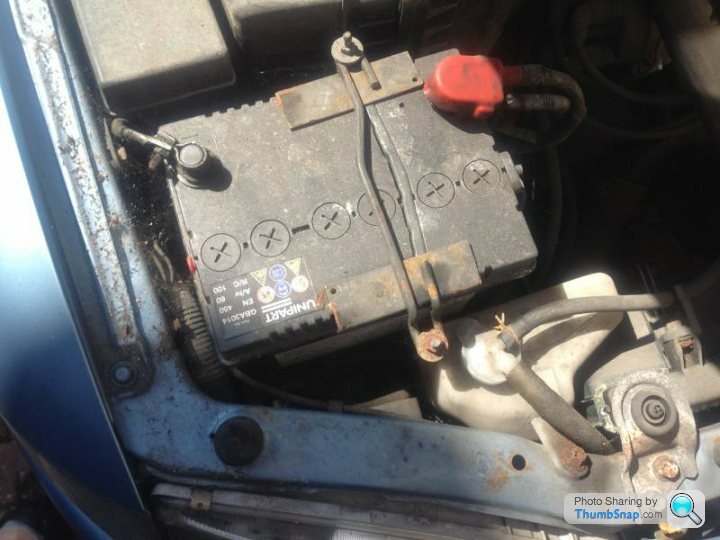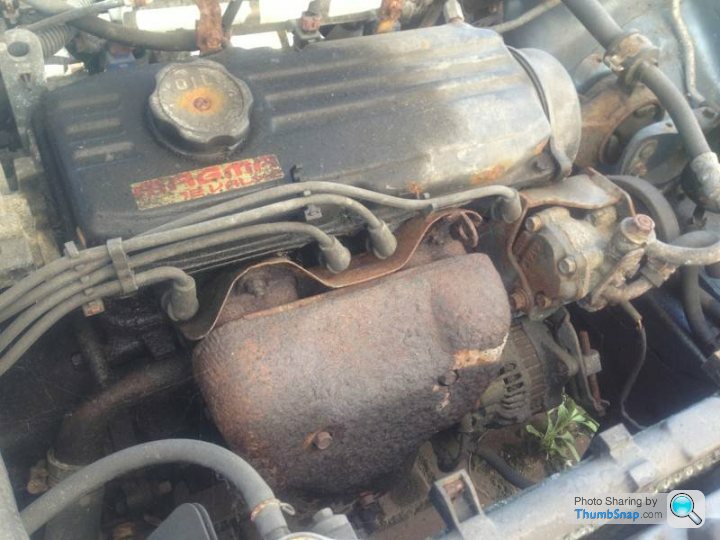Recharging battery + rust near engine on car
Discussion
Hi, I have a 1995 Proton Persona that I'm bringing back into use after 2 years of being parked in the driveway.
I have two questions which I'm hoping someone will know enough to answer...
Firstly, the battery is (obviously after 2 years) completely dead, so I bought a battery charger to recharge it. I'd naively assumed that I could just plug it onto the battery and leave it to charge, but on reading the instructions, they're fairly explicit that I need to remove the battery from the car first and also check and if necessary top up each cell with distilled water. And I can only use the charger if it is a 6V or 12V lead acid battery. This is way beyond my level of mechanical experience so I want to check a few things.
1. I think it's a lead-acid battery, but how can I be certain? It does have a 'Pb' warning on the side which seems hopeful. And how do I tell if it's 6V or 12V? I don't see any markings to indicate the voltage on it. I've attached a photo of the battery with this post.
2. For detaching from the car, is it sufficient to undo the black connection on the left and the red one on the right in the photo? I'd prefer not to have to remove the battery entirely from the car if possible.
3. To check the fluid, is it a question of unscrewing each of the round panels with cross-shaped grooves? And how important is it to do this, given that I'm only going to drive 5 miles to the garage, then the car will have a full service anyway? In particular it going to matter terribly if I miss out the one that the photo shows is inaccessible without removing the battery restraining bar first?
Secondly, I've also attached photo of the engine. There's a panel towards the front of the engine (lower part of photo) which appears severely rusted. It looks to me like it's just a cover, and not part of the engine itself. Is this anything I should be worried about?


I have two questions which I'm hoping someone will know enough to answer...
Firstly, the battery is (obviously after 2 years) completely dead, so I bought a battery charger to recharge it. I'd naively assumed that I could just plug it onto the battery and leave it to charge, but on reading the instructions, they're fairly explicit that I need to remove the battery from the car first and also check and if necessary top up each cell with distilled water. And I can only use the charger if it is a 6V or 12V lead acid battery. This is way beyond my level of mechanical experience so I want to check a few things.
1. I think it's a lead-acid battery, but how can I be certain? It does have a 'Pb' warning on the side which seems hopeful. And how do I tell if it's 6V or 12V? I don't see any markings to indicate the voltage on it. I've attached a photo of the battery with this post.
2. For detaching from the car, is it sufficient to undo the black connection on the left and the red one on the right in the photo? I'd prefer not to have to remove the battery entirely from the car if possible.
3. To check the fluid, is it a question of unscrewing each of the round panels with cross-shaped grooves? And how important is it to do this, given that I'm only going to drive 5 miles to the garage, then the car will have a full service anyway? In particular it going to matter terribly if I miss out the one that the photo shows is inaccessible without removing the battery restraining bar first?
Secondly, I've also attached photo of the engine. There's a panel towards the front of the engine (lower part of photo) which appears severely rusted. It looks to me like it's just a cover, and not part of the engine itself. Is this anything I should be worried about?


You don't have to remove the battery for charging but it is good practice to do so.
The rusty part is just the exhaust manifold heat shield....nothing to worry about.
ETA.
if the battery has been sat discharged for 2 years it is most likely scrap and you should budget on a replacement.
The rusty part is just the exhaust manifold heat shield....nothing to worry about.
ETA.
if the battery has been sat discharged for 2 years it is most likely scrap and you should budget on a replacement.
Edited by magpie215 on Sunday 27th May 21:46
Your battery is a lead acid one. 12v. To check the water in the cells, you need to unscrew the caps. If you can see water above the cells (they look like wafers made of metal) then it's okay, if the water level is underneath the cell, it needs topping up with distilled water. Disconnecting it is a matter of preference.
That metal panel is your exhaust head shield. It's not vital, but I advise not trying to take it off because you'll probably snap the bolts into the manifold. However, it looks like it's rusted away around one of the bolts anyway, so it might rattle a bit when the car starts up.
That metal panel is your exhaust head shield. It's not vital, but I advise not trying to take it off because you'll probably snap the bolts into the manifold. However, it looks like it's rusted away around one of the bolts anyway, so it might rattle a bit when the car starts up.
At the risk of revealing the full extent of my lack of mechanical skills... How do I unscrew the caps on the battery to check the fluid levels? The grooves are far too big for any screwdriver I've seen. I just tried, first with a screwdriver, then with the blunt edge of a knife (since that was bigger), but all either of them did was start to damage the rubber around the grooves.
Thankyou. 50p worked brilliantly. I checked all the cells apart from the one covered by the bar, which I'll check tomorrow. Was a bit hard to see much but there seemed to be fluid quite near the top of each cell, and no sign of any metal plates, so I assume those are all well covered. Thanks for your help, everyone. Thanks to your advice, I'm doing some checks I wouldn't have had the confidence to do otherwise, and it's turning out to be quite interesting.
Gassing Station | Home Mechanics | Top of Page | What's New | My Stuff



